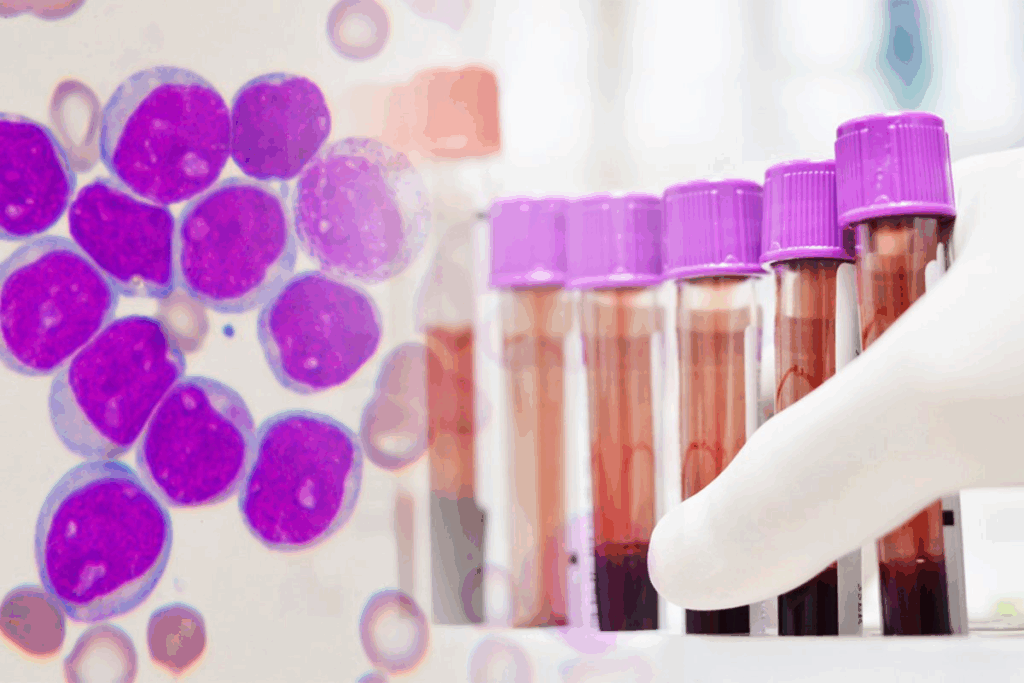
The bone marrow is at the center of our body’s blood cell production. It’s a spongy tissue inside some bones. It has stem cells that turn into red blood cells, white blood cells, and platelets. These are key for carrying oxygen, fighting off infections, and stopping bleeding.
When the bone marrow doesn’t work right, health problems can arise. Bone marrow diseases and disorders happen when stem cells or blood cells don’t develop properly. This can lead to serious conditions like leukemia and aplastic anemia. Knowing about these issues is important for catching them early and treating them well.
At Liv Hospital, we help you understand and manage these complex conditions. We put our patients first in every step of diagnosis and treatment.

Bone marrow is a spongy tissue inside some bones. It’s key to our health. It makes blood cells, which are vital for our body’s functions.
Bone marrow has stem cells that turn into different blood cells. These include red blood cells, white blood cells, and platelets. They carry oxygen, fight infections, and help blood clot.
Our body needs bone marrow to make these cells all the time. Red blood cells last about 120 days. White blood cells can live just a few hours or days. This shows how important healthy bone marrow is.
There are two types of bone marrow: red and yellow. Red marrow makes blood cells and is in bones like the hips and vertebrae. Yellow marrow is mostly fat and is in the long bones’ shafts.
Yellow marrow can turn into red marrow if we need more blood cells. This shows it’s ready to help when needed.
A healthy bone marrow has a balance of cells. It has stem cells, blood cells, and stromal cells. It also has blood vessels and sinusoids for releasing blood cells.
Knowing what healthy bone marrow looks like helps us diagnose and treat problems.
In summary, bone marrow is vital for our health. It makes blood cells. Its proper function is essential for our well-being. Any issues can cause blood-related disorders.

Bone marrow disorders are complex conditions that affect blood cell production. They can cause a range of health problems, from mild to severe. We will look at what they are, how they are classified, their symptoms, and risk factors.
Bone marrow disorders happen when the bone marrow can’t make healthy blood cells. This can affect red blood cells, white blood cells, or platelets. Bone marrow diseases fall into several types, like aplastic anemia and myelodysplastic syndromes.
These categories help doctors understand the disorder and choose the right treatment. They are based on which blood cell is affected and the nature of the problem.
Symptoms of bone marrow disorders vary but often include fatigue, infections, and bleeding. Fatigue happens when there aren’t enough red blood cells. Infections occur when there are not enough white blood cells. Low platelet counts cause bleeding problems.
Other symptoms might be weight loss, fever, and night sweats. The specific symptoms can hint at the underlying disorder.
Several factors increase the risk of bone marrow disorders. These include genetic mutations, exposure to harmful chemicals, and past radiation or chemotherapy. Genetic predisposition is a big factor in some diseases.
Exposure to benzene or pesticides also raises the risk. Knowing these risk factors is key to prevention and early detection.
Leukemia is when abnormal white blood cells grow too much. This makes it hard for the body to fight off infections. It affects the bone marrow and lymphatic system, causing health problems.
Leukemia is divided into two main types: acute and chronic. This depends on the cell type and how fast it grows.
| Type of Leukemia | Cell Type | Progression |
| Acute Lymphoblastic Leukemia (ALL) | Lymphocytes | Rapid |
| Acute Myeloid Leukemia (AML) | Myeloid cells | Rapid |
| Chronic Lymphocytic Leukemia (CLL) | Lymphocytes | Slow |
| Chronic Myeloid Leukemia (CML) | Myeloid cells | Slow |
Leukemia symptoms include feeling very tired, getting sick often, and bleeding. You might also lose weight, have a fever, or notice swollen lymph nodes.
We don’t know exactly why leukemia happens. But some things can increase your risk. These include genetic changes, radiation, and certain chemicals.
Treatment for leukemia depends on the type and how far it has spread. Doctors often use chemotherapy, targeted therapy, or bone marrow transplants.
Getting a leukemia diagnosis is tough. But with the right treatment, many people can manage their condition well.
Aplastic anemia is a rare and serious condition. It happens when the bone marrow can’t make enough blood cells. This can cause anemia, infections, and bleeding.
In aplastic anemia, the bone marrow can’t make blood cells. This includes red blood cells, white blood cells, and platelets. Without these, you might get anemia, infections, and bleeding.
The bone marrow fails because of an immune attack on its stem cells. These cells are key to making blood.
The symptoms of aplastic anemia come from not having enough blood cells. You might feel tired and short of breath because of anemia. You could also get infections easily and bruise or bleed a lot.
Aplastic anemia can be either caused by something you get or something you’re born with. The acquired type is often from toxins, radiation, or certain medicines. The inherited type is linked to genetic mutations.
Treatment for aplastic anemia depends on how severe it is and what caused it. Options include immunosuppressive therapy to calm down the immune system and bone marrow transplantation to replace damaged marrow with healthy cells.
Supportive care, like blood transfusions, is also important for managing the condition.
Myelodysplastic syndromes are a group of blood disorders. They affect how the bone marrow makes blood cells. This can lead to serious health issues.
The way we classify MDS has changed over time. Different systems are used to group these disorders. The World Health Organization (WHO) system is widely used. It sorts MDS into subtypes based on bone marrow findings and genetic changes.
The main subtypes include:
People with MDS may have symptoms like anemia, infections, and bleeding. How severe these symptoms are can vary. It depends on the type of MDS and other factors.
Some MDS patients may develop acute myeloid leukemia (AML). This can happen quickly or take a long time.
Several things can increase the risk of getting MDS. These include exposure to harmful chemicals, radiation, and some types of chemotherapy. Genetics also plays a role, with certain mutations raising the risk.
Managing MDS involves different approaches. Supportive care, like blood transfusions and antibiotics, helps manage symptoms. For those with higher-risk MDS, treatments like hypomethylating agents and lenalidomide may be used.
Hematopoietic stem cell transplantation is a possible cure for MDS. But it’s risky and usually only for younger patients with high-risk disease.
It’s key to tailor treatment plans for MDS patients. This means considering their disease, health, and personal preferences.
It’s important to know about bone marrow disorders in kids to help them get better. Some conditions are the same in all ages, but others are only found in children. They can have different effects on kids.
Children can have special bone marrow problems that are passed down in their genes. These issues can really affect their life and the lives of their families and doctors.
Diamond-Blackfan anemia is a rare genetic disorder. It makes it hard for the bone marrow to make red blood cells. It usually starts in babies or young kids and leads to severe anemia. Kids with this condition need to get blood transfusions for life.
Key features of Diamond-Blackfan anemia include:
Shwachman-Diamond syndrome is a rare genetic disorder that affects the bone marrow and pancreas. Kids with this condition often have low white blood cell counts, get sick a lot, and don’t grow well.
The syndrome is also associated with an increased risk of developing myelodysplastic syndrome or acute myeloid leukemia.
Fanconi anemia is a genetic disorder that causes bone marrow failure, birth defects, and a higher risk of cancer. It can lead to serious health problems like aplastic anemia and leukemia.
Treatment for Fanconi anemia often involves:
Many bone marrow disorders in kids are caused by genes. Knowing about these genes helps doctors diagnose and treat the conditions. It also helps families understand their risk.
Genetic testing has gotten better at finding these conditions. It helps doctors give the right treatment. Scientists are always finding new ways to treat these complex diseases.
Myeloproliferative neoplasms are diseases where the bone marrow makes too many blood cells. This can cause serious problems. It can lead to too many red blood cells, white blood cells, or platelets. This can cause blood clots, bleeding, and even leukemia.
Polycythemia vera is a disease in which the bone marrow makes too many red blood cells. This makes blood thick, raising the risk of blood clots and heart problems. Symptoms include headaches, dizziness, and itching, often after bathing.
Key characteristics of polycythemia vera include:
Essential thrombocythemia is a disease in which the bone marrow makes too many platelets. This can cause blood clots and bleeding. Symptoms include headaches, dizziness, and a burning sensation in the hands and feet.
Key features of essential thrombocythemia are:
Primary myelofibrosis is a serious disease where the bone marrow scars. This makes it hard to make blood cells. It can cause anemia, fatigue, and an enlarged spleen. If it gets worse, it can lead to bone marrow failure.
Notable aspects of primary myelofibrosis include:
Chronic myeloid leukemia (CML) is a disease in which the bone marrow grows too many cells. It grows slowly but can get worse if not treated. Symptoms include fatigue, weight loss, and an enlarged spleen.
Key aspects of CML include:
It’s important to know about multiple myeloma and plasma cell disorders to find good treatments. Multiple myeloma is a cancer that affects plasma cells. It causes too much of a certain protein, leading to pain, anemia, and infections.
Multiple myeloma starts when bad plasma cells grow in the bone marrow. These cells take over and stop normal blood cells from being made. This leads to anemia, infections, and bone damage.
The disease gets worse because of genetic and epigenetic changes. These changes help the cancer cells grow and survive. They also make the cancer resistant to treatments.
People with multiple myeloma often have bone pain, broken bones, anemia, high calcium levels, and infections. These problems come from the cancer cells taking over and making too much protein.
They might also feel tired, lose weight, and have kidney problems. Doctors use tests like blood work, bone marrow biopsies, and scans to diagnose it.
We don’t know exactly why multiple myeloma happens, but some things increase the risk. These include getting older, having a family history, being exposed to harmful chemicals, and radiation. Some genetic changes also play a part.
There are many ways to treat multiple myeloma now. These include chemotherapy, targeted therapy, immunotherapy, and stem cell transplants. The best treatment depends on the patient’s health and the disease’s details.
| Treatment Approach | Description | Benefits |
| Chemotherapy | Uses drugs to kill cancer cells | Effective in reducing tumor burden |
| Targeted Therapy | Targets specific molecules involved in cancer growth | Can be more precise with fewer side effects |
| Immunotherapy | Boosts the body’s immune system to fight cancer | Offers a chance for long-term control |
| Stem Cell Transplantation | Replaces damaged bone marrow with healthy stem cells | Can lead to remission in some patients |
In summary, multiple myeloma and related disorders are complex. Understanding them helps doctors create better treatment plans. This approach is tailored to each patient’s needs.
We see many rare bone marrow disorders, including failure syndromes. These conditions make it hard for the bone marrow to make enough blood cells. This leads to many problems.
Paroxysmal nocturnal hemoglobinuria (PNH) is a rare and serious blood disease. It causes red blood cells to break down, the bone marrow to fail, and blood clots to form. Symptoms include tiredness, short breath, and blood in the urine.
To diagnose PNH, doctors use flow cytometry to check for missing proteins on cells. Eculizumab has been a big help in treating PNH by reducing red blood cell destruction.
Hemophagocytic lymphohistiocytosis (HLH) is a rare immune system disorder. It causes the immune system to overreact, leading to inflammation and organ damage. It can be inherited or caused by infections, cancers, or autoimmune diseases.
Symptoms include fever, a big spleen, and low blood counts. Doctors diagnose HLH with clinical findings, lab tests, and sometimes a bone marrow biopsy. Treatment aims to control the immune system’s overactive response.
Gaucher disease is a genetic disorder caused by a missing enzyme. This leads to the buildup of substances in cells, affecting the bone marrow, spleen, and liver. Symptoms include anemia, low platelets, and bone problems.
Treatment for Gaucher disease is enzyme replacement therapy (ERT), which helps with many symptoms. Other storage disorders also impact the bone marrow, showing the need for correct diagnosis and treatment.
Mastocytosis is when mast cells build up in organs like the bone marrow, skin, and gut. It can cause mild symptoms or serious problems.
Doctors diagnose mastocytosis with clinical evaluation, lab tests, and sometimes a bone marrow biopsy. Treatment depends on the disease’s severity and symptoms, from managing symptoms to specific therapies.
In conclusion, bone marrow failure syndromes and rare disorders are complex. Understanding them is key to better care and outcomes for patients.
It’s important to know how to diagnose and treat bone marrow problems. Finding out what’s wrong with the bone marrow takes several steps. Each step gives us important information about the bone marrow’s condition.
Blood tests are usually the first step in finding bone marrow problems. These tests can show if there are issues with blood cell counts. For example, a complete blood count (CBC) can spot problems with blood cell production.
Bone marrow aspiration and biopsy are key for diagnosing many bone marrow disorders. A sample of bone marrow is taken from the hipbone or another large bone. Then, it’s checked under a microscope to see how well the bone marrow cells are working.
Genetic testing is very important for diagnosing some bone marrow disorders, like leukemia. These tests look for genetic mutations that might be causing the disease. They help doctors decide on the best treatment.
Genetic testing also gives clues about how the disease might progress and how well it might respond to treatment.
Treatment for bone marrow problems varies a lot. It depends on the specific condition. Doctors might use medicines like chemotherapy or immunosuppressive therapy. Sometimes, a bone marrow transplant is needed.
This transplant replaces the sick bone marrow with healthy marrow. It can come from the patient themselves (autologous transplant) or from a donor (allogeneic transplant). The choice of treatment depends on the diagnosis, the patient’s health, and other factors.
Understanding bone marrow disorders is key to better management and treatment. We’ve looked at conditions like leukemia, aplastic anemia, and myeloproliferative neoplasms. We’ve discussed their symptoms, causes, and treatment options.
Living with these disorders requires a team effort. Patients need to work closely with their doctors to manage their condition. This helps improve their quality of life. Research is ongoing to find better ways to diagnose and treat these diseases.
New advancements in genetic testing and bone marrow transplantation are giving patients hope. We’re also exploring new treatments like targeted therapies and immunotherapies. By learning more about these disorders, we can create more effective treatments and better outcomes for patients.
Bone marrow disorders happen when the bone marrow can’t make healthy blood cells. This can cause anemia, infections, and bleeding problems.
Symptoms include feeling tired, weak, and pale. You might also get short of breath, have frequent infections, or bruise easily. Some people may also have bone pain, lose weight, or sweat a lot at night.
Leukemia is a cancer in the bone marrow. It affects blood cell production. Treatment can be chemotherapy, targeted therapy, or bone marrow transplant, based on the disease’s type and severity.
Aplastic anemia means the bone marrow can’t make blood cells. It can be caused by toxins or certain medicines, or it can be inherited due to genetic mutations.
MDS is are disorder where the bone marrow makes abnormal blood cells. Treatment includes blood transfusions and, in some cases, stem cell transplantation.
Myeloproliferative neoplasms occur when the bone marrow makes too many blood cells. Symptoms vary by type, such as polycythemia vera or essential thrombocythemia.
Doctors use blood tests, bone marrow aspiration, and genetic testing to diagnose bone marrow disorders. These tests check the bone marrow’s function and look for abnormalities.
Treatments include medicines, targeted therapies, and bone marrow transplantation. The choice depends on the condition, its severity, and the patient’s health.
Yes, there are rare syndromes like paroxysmal nocturnal hemoglobinuria and Gaucher disease. Each has its own cause and symptoms.
Yes, personalized plans are key. Treatment is tailored to the individual’s condition, health, and response to therapy. This aims to improve outcomes and quality of life.
Knowing how bone marrow works is vital. It helps understand diseases impact on health. This leads to early diagnosis and proper treatment.
There is red marrow, which makes blood cells, and yellow marrow, which has fat cells. The mix of red to yellow marrow changes with age.
Genetics plays a role in many bone marrow disorders. Inherited conditions like Fanconi anemia affect disease development and treatment.
Subscribe to our e-newsletter to stay informed about the latest innovations in the world of health and exclusive offers!
WhatsApp us